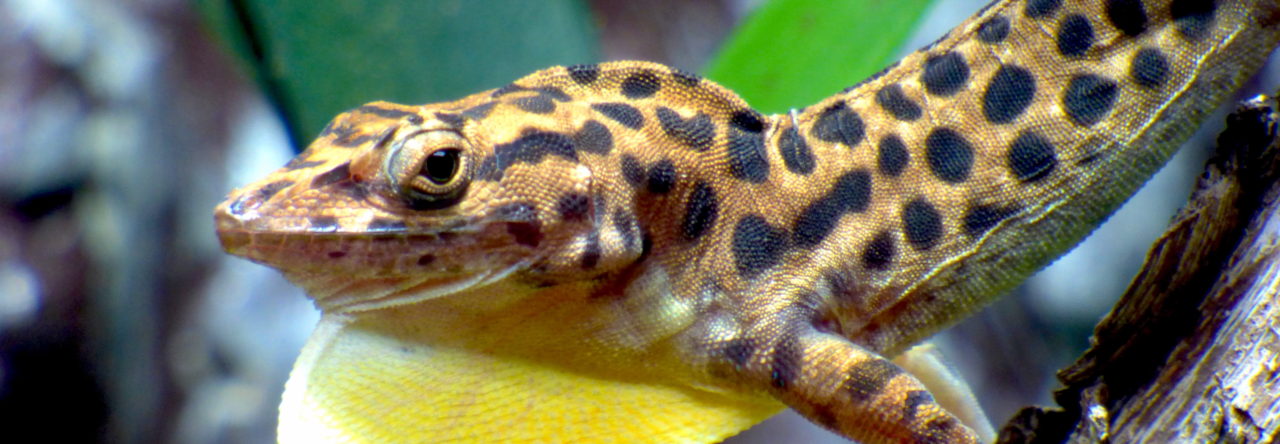Last week, Miguel Landestoy provided the details on the discovery of Anolis landestoyi, the new species from the Dominican Republic. The paper was published recently in The American Naturalist. Here’s what the press had to say:
The Canadian Broadcast Corporation:
A Caribbean lizard that remained undiscovered for many years despite its large size and distinctive looks has been identified as a new species.
The lizard, an anole that looks like a chameleon and has a similar talent for camouflage, lives in the canopy of a rare type of forest in the western Dominican Republic. Adults have a body length of up to 13.5 centimetres and a tail up to 18 centimetres long, making them unusually large for an anole. The new species is described as a “giant chameleon-like lizard” in a study published in the journal The American Naturalist.
The lizard was first spotted in 2007 by Dominican naturalist Miguel Landestoy while he was studying endangered birds called bay-breasted cuckoos.
‘There’s nothing else like that in and around the island.’– Luke Mahler, University of Toronto
“He noticed that these birds were agitated and seemed to be attacking something,” recalled Luke Mahler, a University of Toronto biologist and the lead author of the new study.
When Landestoy got closer, he saw a lizard and snapped a picture of it.
Convinced it was a new species, he showed the photo to Mahler, a lizard researcher who was working in the Dominican Republic at the time. But the photo was so grainy that Mahler couldn’t tell much other than it was an anole. He suggested that Landestoy try to capture a specimen.
Several years later, Landestoy spotted the lizard again and took some better photos.
“As soon as he sent the pictures,” Mahler recalled, “I was like, ‘What the expletive is that? … There’s nothing else like that in and around the island.”
He added that the Caribbean has been very well explored, so that typically, any new species found there are so similar to existing species that they can only be distinguished with DNA testing.
The new lizard was a big anole, with stubby limbs, a short tail, and green-grey and light brown scales that help it blend in among the moss-covered branches of the semi-dry tropical forest where it lives.
“It’s super camouflaged, basically. It looks just like the bark,” said Mahler, who thinks that’s why it’s never been spotted before. “It’ll sit there and hug a branch and very slowly move one limb at a time.”
The lizard is similar to related anoles found in Cuba called chamaeleolisor chamaeleonides because they’re also chameleon-like.
Different islands, similar adaptations
That’s intriguing because biologists have always expected to find a lizard similar to chamaeleonides on Hispaniola, the island shared by Haiti and the Dominican Republic. Islands in the Caribbean tend to have similar environments and tend to evolve species with similar adaptations, even if they are not closely related.
Mahler says more analysis needs to be done to figure out if the new lizard is similar to the chamaeleonides lizards because it’s closely related or because it evolved similar adaptations over time.
The new lizard has been named Anolis landestoyi after its discoverer.
Sadly, even though the new species was so recently discovered, it may not be around for much longer.
“We think that they’re probably quite endangered,” Mahler said.
That’s because it lives in a unique type of forest halfway up a mountain slope close to the border with Haiti. Although the forest is in a reserve called Lomo Charco Azul that’s officially protected, it’s threatened by illegal logging for agriculture, livestock grazing, and firewood.
The researchers are requesting that the new lizard be officially listed as critically endangered. They hope the new discovery will help draw attention to the threats to its habitat and lead to better protection.
Science Newsline:
We tend to think the contours of biodiversity are well known, especially in extensively studied areas. However, this is not necessarily the case and sometimes strikingly new species are discovered even in well-trod areas. A case in point is the country of the Dominican Republic, which has been thoroughly studied by biologists for more than 40 years, particularly by herpetologists who have exhaustively catalogued the reptiles and amphibians there for several decades.
Read More






















